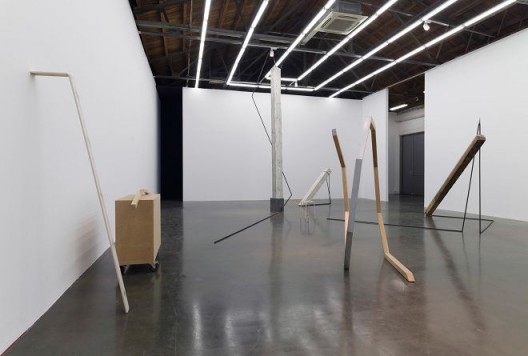Beijing Commune (798 Art Zone, No.4 Jiuxianqiao Road, Chaoyang District, Beijing, China), Nov 11, 2015–Jan 2, 2016
Hu Xiaoyuan has spoken of her tendency to coin her own terms in order to set forth her creative ideas as accurately as possible. Although the “surface meanings” of these new terms are detached from the cognitive systems we are accustomed to everyday, patterns and traces of meaning remain detectable in her finished works made from existing materials. “Ant Bone” draws from the many contradictions found in the ant: its minuscule size and formidable strength, its tough yet restrictive exoskeleton, and the delicacy of its unyielding frame. These two concise words together encompass a wealth of description—as befits the exhibition’s spirit of simplicity.
The exhibition space has been divided into two parts—“dark” and “light”. Pieces in the “light” part extend the basic structure of the Wood series that the artist began exploring in 2008. Hu Xiaoyuan’s creative output has slowly transitioned from private subject matter to more abstract concepts. As a result, her work remains quite “polished” or “refined”, but it no longer reveals any archetypal “gendered” characteristics. In this series, Hu Xiaoyuan has copied the grain of wood onto silk, using lines as thin and fine as skeins of hair. According to the artist, this is a visual translation of the Buddhist concept of sunyata or “emptiness”. Undoubtedly, the act of painting the textures of the grain of wood on silk demands a high level of concentration. Once the mind is clear of external distractions, the process of retracing the patterns of nature mirrors the Buddhist spiritual journey into the highest realms of Dharma. However, the religious aspects of Hu’s work may be overly obscure, and they might not move viewers—at least not immediately. The seemingly solid structure of these works actually rests on the verge of stability derived from the meticulous arithmetic calculations. The artist has designed an ingenious “coat” which restricts the “movement” of her artworks, and yet the tenuous appearance of this reinforcing structure temporarily robs the framework of its rigidity. Stability and turmoil, freedom and limitation, tenacity and weakness— all of these concepts co-exist in her work.
If the pieces in the “light” section are abstract, then the pieces in the “dark” section are concrete representations. For instance, in the 5-channel video work “The Character of Human Nature”, the camera trains its focus on the upheld arms on two people—who steady their arms to avoid a needle from piercing a balloon. Another segment of the video limits the frame to showing three right hands, with each hand drawing a circle on another right wrist—the subjects are thus again compelled to work together within the limitations of their motions.





